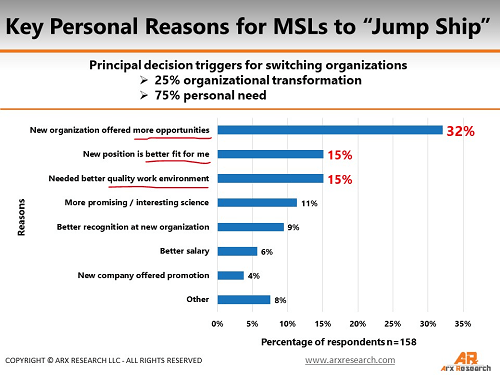We have often heard through our conversations with clients how Medical Affairs programs suffer from the “revolving door” disease, meaning that a significant contingent of MSLs don’t stick around for long periods at the organizations (yes, with an S…!) they work for. To some degree, this also applies to upper management roles. So, what are the top reasons for MSL turnover?
Unfortunately, high turnover affects overall organizational performance and greatly upsets the links built between External Experts and the Medical Affairs function, on top of the turmoil it creates internally. All these disturbances are, understandably, very costly to absorb, and time-consuming to rectify.
So, we recently surveyed Medical Science Liaisons to learn what triggers them to switch organizations, how long they have stayed, and how many organizations they have worked for, so far.
The average time spent/stayed at the same organization of the surveyed sample (n=165) is 42.5 months or just about 3.5 years. While 56% of survey respondents have worked for only one (1) organization, 30% indicated they are on their third or more organization to work for as an MSL. Also, to be clear, the 56% of individuals who have reported working for one organization include 15% of new MSLs who have been in the role for less than 2 years.
As shown in the graphic below, the primary cause for switching organizations originates from a personal decision, accounting for 75% of respondents’ answers, while 25% were caused by organizational changes (consolidation, acquisition, downsizing), forcing Medical Science Liaisons to seek new grounds.
As the data shows, Medical Science Liaisons are driven to switch organizations mostly because of career advancement opportunities. MSLs might sense they have reached the limit of their growth potential within the current organization, or that the organization’s structure is somewhat rigidly set in a way that it doesn’t allow much lateral or horizontal moves; they will therefore look elsewhere, where they expect their new job will offer more challenging roles and lead-ins to move up the career ladder, as reported by 32% of survey-takers.
Meanwhile, 30% of respondents indicated they changed organization to find a better fit or better-quality work environment. The new position might be a closer match to their own profile as it relates to specific scientific knowledge or background. MSLs changing organization for a better work environment might be looking for a different culture, values or work-life balance, access to perks not offered at their current organization, be able to maintain a territory closer to home, have a leadership more in tune with their personal goals.
It seems that compensation, earning more money or receiving better benefits, does not weigh heavily on the decision to change organization, with only 6% of respondents indicating it as the primary reason why they jumped from one company to another. In any case, since the average annual compensation of a Medical Science Liaison is fairly substantial, it shouldn’t be the main trigger to make the decision to switch organization. Similarly, only 4% of respondents pointed to the fact that changing organizations gave them an instant promotion.
While the top reasons for MSL turnover presented here cover most motives, it’s important to note that each individual MSL may have multiple reasons for changing organizations, and the decision to change jobs can be a complex one. Additionally, they should weigh the pros and cons of the impacts on their career and personal life before moving from one outfit to another, especially if moves happen too frequently.







